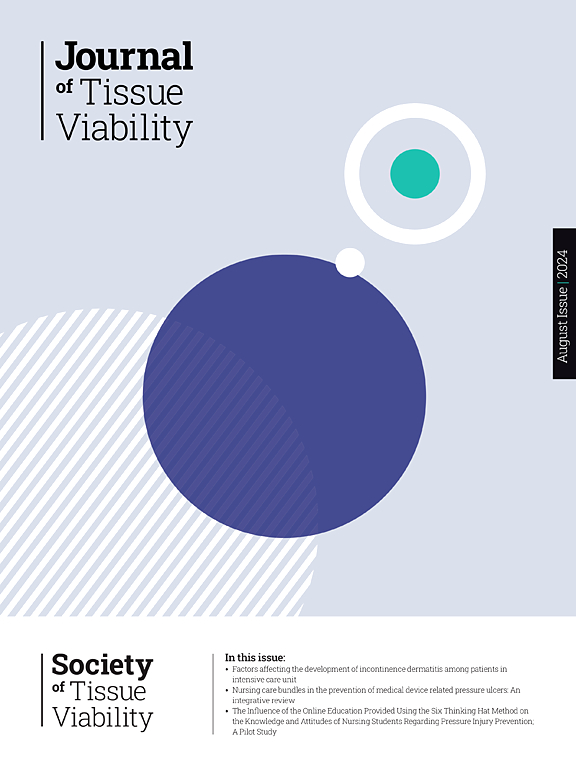An exploration of barriers to and enablers of offering treatments to prevent recurrence of venous leg ulcers
IF 2.4
3区 医学
Q2 DERMATOLOGY
引用次数: 0
Abstract
Aim
To: (1) explore the factors influencing the offering of venous leg ulcer (VLU) recurrence preventative treatments from the perspective of NHS nurses, and (2) recommend potential intervention strategies to ameliorate inhibitors to offering those preventative treatments.
Methods
This qualitative study used semi-structured online interviews with seventeen NHS nurses who provide wound care. The interviews were guided by the Capabilities, Opportunities and Motivation model of Behaviour change (COM-B). Framework Analysis, incorporating inductive coding to capture emergent themes and deductive coding informed by the Theoretical Domains Framework (TDF) was conducted. NVivo software aided data management, and coding was conducted collaboratively by an interdisciplinary team.
Results
Data were mapped to six relevant TDF domains. Three of these domains were found to influence offering of both preventative treatments. While nurses understood the importance of VLU care post-healing, there was a perception of limited provision of prophylactic treatments in NHS organisations (environmental context and resources), which can be reflected in the lack of embedding national guidelines into local pathways (memory, attention and decision processes). Nevertheless, some nurses acknowledged the significance of their role in offering those prophylaxis with their patients (social/professional role and identity).
In addition to the primary three domains, two more domains were identified influencing offering of prophylactic compression. While some nurses lacked confidence in offering the strongest tolerated compression (beliefs about capability), working within an experienced team was perceived to enhance their confidence and support optimal prescription of prophylactic compression. Furthermore, with the primary three domains, one additional domain was identified influencing referrals to vascular services. Nurses interviewed were largely unaware of endo-venous ablation surgery as a prophylactic treatment option for people with healed VLUs (knowledge). Five intervention functions (environmental restructuring, enablement, education, modelling and persuasion), and nine behaviours change technique groupings (goals and planning, antecedents, associations, self-belief, comparison of behaviour, repetition and substitution, comparison of outcomes, social support and shaping knowledge) were identified.
Conclusions
The identified intervention functions and the behaviour change techniques can inform the design of future intervention. Key targets for change include service-focused elements on VLU care after healing and the integration of national guidelines with local resources to aid decision-making and boost opportunities to offer evidence-based approaches to reduce or prevent recurrence of VLUs.
探索障碍和使能提供治疗,以防止静脉腿溃疡复发
目的:(1)从NHS护士的角度探讨影响静脉性腿溃疡(VLU)复发预防治疗的因素,(2)推荐潜在的干预策略,改善抑制剂以提供这些预防治疗。方法本定性研究采用半结构化的在线访谈,采访了17名提供伤口护理的NHS护士。访谈以行为改变的能力、机会和动机模型(COM-B)为指导。框架分析,结合归纳编码捕捉紧急主题和演绎编码的理论领域框架(TDF)进行。NVivo软件辅助数据管理,编码由跨学科团队协同完成。结果数据被映射到6个相关的TDF域。其中三个领域被发现影响两种预防性治疗的提供。虽然护士理解VLU治疗后护理的重要性,但人们认为NHS组织(环境背景和资源)提供的预防性治疗有限,这可以反映在缺乏将国家指南嵌入当地途径(记忆,注意力和决策过程)。然而,一些护士承认他们在为患者提供这些预防方面的作用(社会/专业角色和身份)的重要性。除了主要的三个领域,另外两个领域被确定影响预防性压缩的提供。虽然一些护士对提供最强耐受压迫缺乏信心(对能力的信念),但在经验丰富的团队中工作被认为可以增强他们的信心并支持最佳预防性压迫处方。此外,与主要的三个领域,一个额外的领域被确定影响转介到血管服务。受访的护士大多不知道静脉内消融手术作为一种预防治疗选择,为愈合的vlu的人(知识)。确定了五种干预功能(环境重组、使能、教育、建模和说服)和九种行为改变技术分组(目标和计划、前因、关联、自信、行为比较、重复和替代、结果比较、社会支持和塑造知识)。结论确定的干预功能和行为改变技术可为今后的干预设计提供指导。改革的关键目标包括以服务为重点的VLU康复后护理要素,以及将国家指南与地方资源相结合,以帮助决策,并增加提供循证方法的机会,以减少或预防VLU的复发。
本文章由计算机程序翻译,如有差异,请以英文原文为准。
求助全文
约1分钟内获得全文
求助全文
来源期刊

Journal of tissue viability
DERMATOLOGY-NURSING
CiteScore
3.80
自引率
16.00%
发文量
110
审稿时长
>12 weeks
期刊介绍:
The Journal of Tissue Viability is the official publication of the Tissue Viability Society and is a quarterly journal concerned with all aspects of the occurrence and treatment of wounds, ulcers and pressure sores including patient care, pain, nutrition, wound healing, research, prevention, mobility, social problems and management.
The Journal particularly encourages papers covering skin and skin wounds but will consider articles that discuss injury in any tissue. Articles that stress the multi-professional nature of tissue viability are especially welcome. We seek to encourage new authors as well as well-established contributors to the field - one aim of the journal is to enable all participants in tissue viability to share information with colleagues.
 求助内容:
求助内容: 应助结果提醒方式:
应助结果提醒方式:


